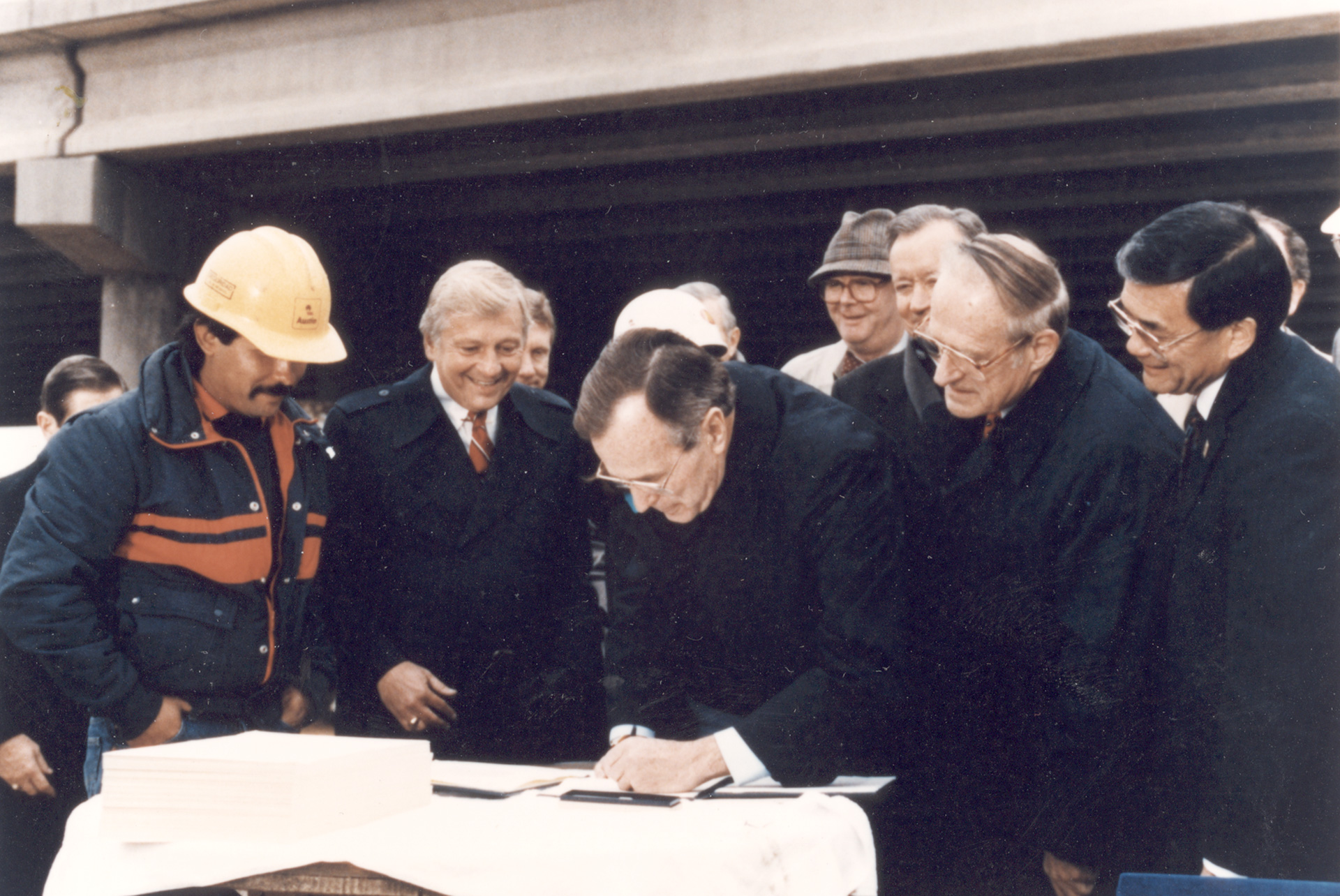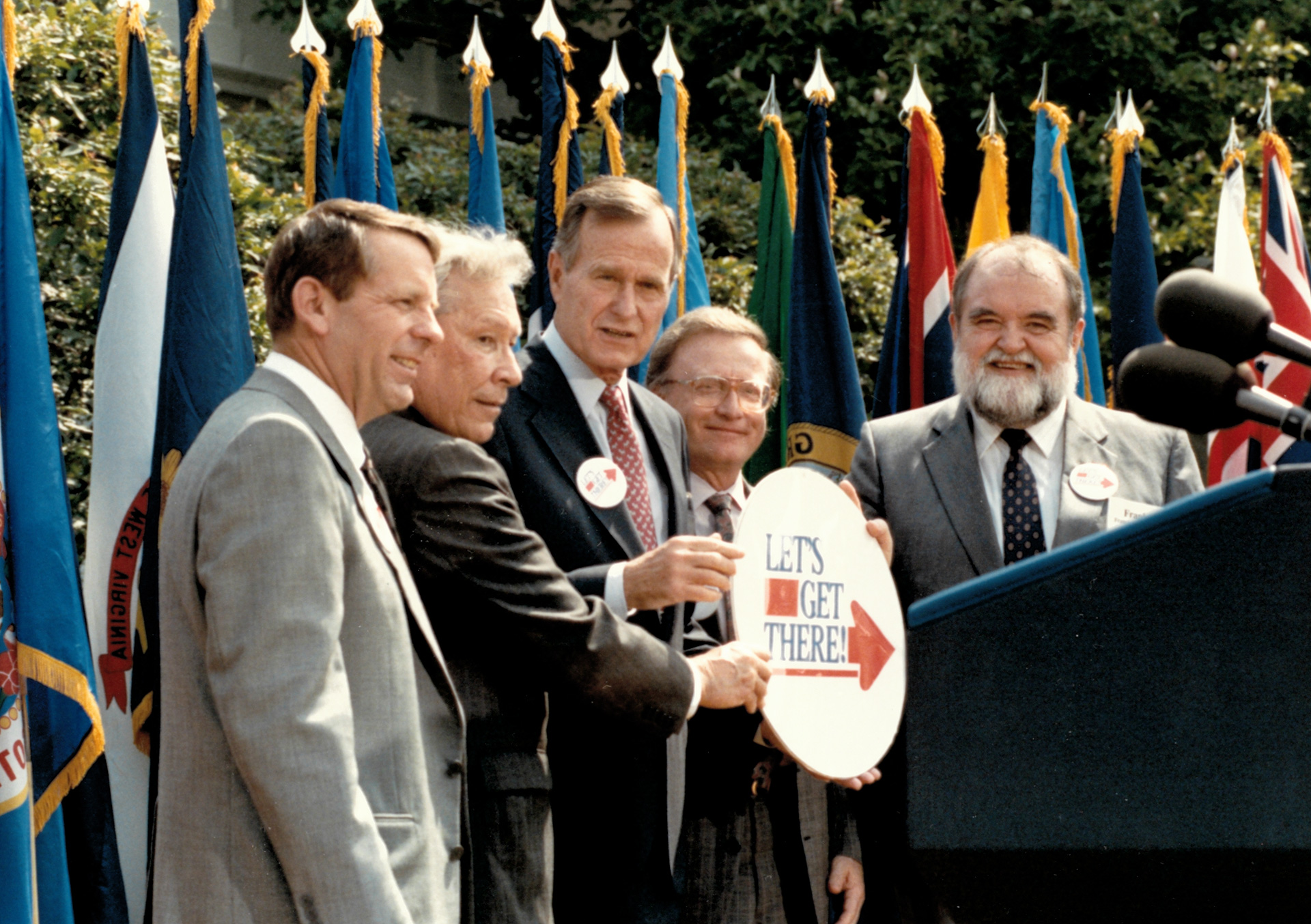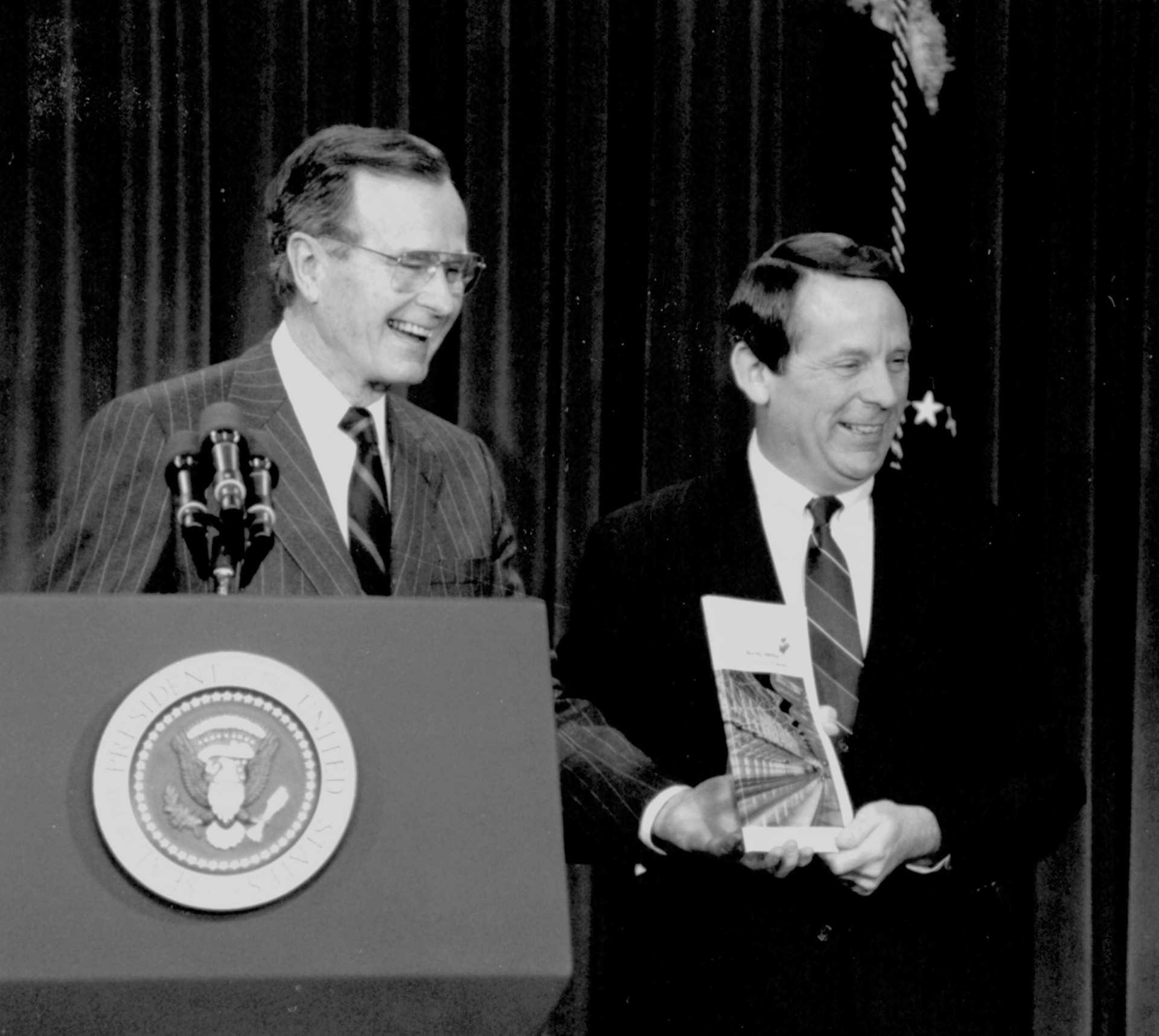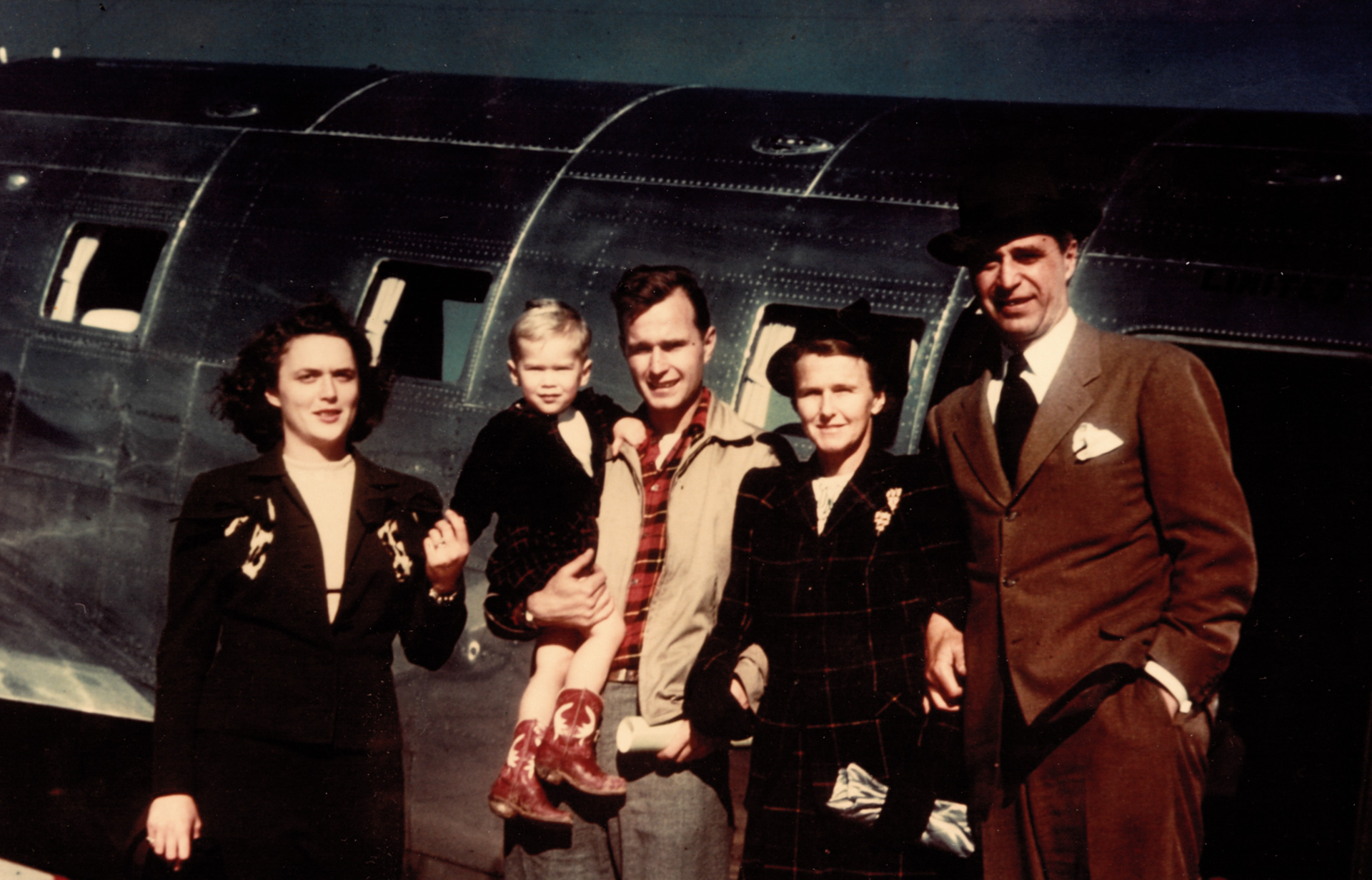In Memory of President George H. W. Bush (1924-2018) The Man Who Brought About the Post-Interstate Era
By Richard F. Weingroff

Former President George H. W. Bush died on November 30, 2018, at the age of 94. In the following days, admirers, citizens, commentators, family, friends, historians, politicians, and many others recalled the man who accomplished so many things in his long life. Few recalled his impact on the Federal-aid highway program resulting from his promotion of the transformative Intermodal Surface Transportation Efficiency Act of 1991.
President Bush's father, Prescott Bush, earned a fortune with the investment firm of Brown Brothers, Harriman, and Company. One of his principles was that the more advantages a man has, the greater his obligation to do public service. In 1953, he won election to represent Connecticut in the United States Senate. Assigned to the Committee on Public Works'Subcommittee on Roads, Senator Bush played a key role during debate on the landmark Federal-Aid Highway Act of 1956 that launched construction of the Interstate System. He also backed a 1956 bill to create the post of Federal Highway Administrator to head the Bureau of Public Roads, with the Administrator nominated by the President and subject to Senate confirmation.
Senator Bush's son, George Herbert Walker Bush, moved his family to Texas, where he would make his own fortune in the oil business. Following his father's principle of public service, Bush would serve in a succession of positions. He was a member of the U.S. House of Representatives (1967-1971), Ambassador to the United Nations (1971-1973), Chief of the U.S. Liaison Office to the People's Republic of China (1974-1975), Director of the Central Intelligence Agency (1976-1977), and Vice President under President Ronald Reagan (1981-1989).

In 1988, he defeated Massachusetts Governor Michael Dukakis to become President. Accepting the nomination, he told the Republican Party, "Read my lips, no new taxes," one of his biggest applause lines.
President Bush selected an attorney, Samuel K. Skinner, to be the Nation's 10th Secretary of Transportation. As U.S. Attorney in Illinois, his no-nonsense approach to public corruption cases had earned him the nickname "Sam the Hammer." He was chairman of the Regional Transportation Authority of northeastern Illinois, a mass transportation district, before his appointment as Secretary.
The Deputy Secretary would be Elaine L. Chao, formerly head of the Federal Maritime Commission. (She would later serve as Secretary of Labor during the Administration of President Bush's son, President George W. Bush, before returning to the Transportation Department as Secretary in 2017.)
Dr. Thomas D. Larson would serve as Federal Highway Administrator. As a Professor of Civil Engineering and an Administrator at Penn State University, he had been involved in creation of the Pennsylvania Department of Transportation, served as its Secretary for 8 years (1979-1987), and was an active leader in the American Association of State Highway and Transportation Officials, including its president in 1986, and the Transportation Research Board.

As Administrator, Dr. Larson saw his mission as helping the Federal Highway Administration (FHWA) move from the Interstate to the post-Interstate era. The Surface Transportation and Uniform Relocation Assistance Act of 1987 (STURRA) was widely seen as having provided the final authorizations for the Interstate construction program. Senator Daniel Patrick Moynihan, a senior figure on the Committee on Environment and Public Works, told the Senate during the STURAA debate, "We are about to enter a new era."
By the time President Bush took office on January 20, 1989, the transportation community had been considering the post-Interstate era for several years. Many organizations, together and separately, were studying the Federal-aid highway and transit programs, other transportation needs, and the philosophy behind the program going forward.
Shortly after taking office in 1989, Secretary Skinner initiated a plan to develop a National Transportation Policy (NTP) based on a complete assessment of the U.S. transportation system, including transportation needs through the year 2050. To head the "Moving America" initiative, Secretary Skinner selected Deputy Secretary Chao and Dr. Larson. After extensive internal review, consideration of the work of other organizations, and public outreach, the NTP unveiled Moving America: New Directors, New Opportunities . It presented guidelines and legislative, regulatory, budget, and program initiatives.
The media treats the U.S. Department of Transportation as one of the backburner Cabinet departments, well behind the Departments of Defense, State, Treasury, and Justice in public, and therefore media, interest. In this case, however, President Bush attracted national media attention by joining with Secretary Skinner to release Moving America during a ceremony on March 8, 1990. President Bush called it "our blueprint . . . for this new world."
The reception was mixed, as might be expected for such a wide-ranging report. The Associated Press summed up the reaction by quoting an unnamed critic who described the NTP as "all flash and no cash."
In 1990, the White House also was working with a bipartisan coalition in Congress on a budget plan to reduce the Federal deficit. During a televised address on October 2, President Bush announced the agreement, which included an enforceable cap on discretionary spending, based on a "pay as you go" system that twinned spending increases with reductions elsewhere to pay for it. The plan also included tax increases that violated his "no new taxes" pledge. One of the changes was a 5-cent a gallon increase in the gas tax that brought the total tax to 14.1 cents. Of the nickel, 2.5 cents went to deficit reduction and 2.5 cents went to the Highway Trust Fund.
He called the plan "the biggest deficit reduction agreement ever - half a trillion dollars." It involved "no smoke, no mirrors, no magic act, but real and lasting spending cuts." He acknowledged the tax increases, saying "I'm not, and I know you're not, a fan of tax increases." He had accepted the increases because the budget accord would allow the economy to grow while being fair to all interests.
In retrospect, the agreement was an important step in achieving surplus budgets during President Bill Clinton's two terms (for fiscal years 1998-2001). For President Bush, however, the agreement and the violation of the "no new taxes" pledge contributed to the defeat of his reelection bid in 1992 - and the hardening of opposition to tax increases. (Legislation in 1993 raised the fuel tax for deficit reduction by 4.3 cents a gallon, bringing the total to 6.8 cents for that purpose. Eventually, the entire amount was directed to the Highway Trust Fund for a total of 18.4 cents a gallon - the same as today - for highways and transit.)
A President has many responsibilities. And yet On February 13, 1991, President Bush took time off from war preparations aimed at expelling Iraq from Kuwait to join Secretary Skinner to unveil the Surface Transportation Assistance Act of 1991 (STAA), based on the NTP, in a White House press conference. The bill proposed a reordering of Federal-aid programs to focus Federal attention on national concerns, leaving State and local officials to set the agenda to address their transportation needs. "It's time to take the first step on the long road that lies ahead," the President said, "and the status quo will simply not get us there."
On March 6, 1991, President Bush addressed a joint session of Congress to discuss the Persian Gulf war, which allied forces commanded by General Norman H. Schwarzkopf had brought to a swift, decisive end with the surrender of Iraqi forces on February 28. Near the conclusion of the speech, the President indicated that with the war ended, "Our first priority is to get this economy rolling again . . .[and] enact the legislation that is key to building a better America." One of the bills he cited was the STAA. He saw the pending reauthorization bill, with its reordering of priorities for the post-Interstate era, as a source of public works jobs that would boost the economy out of its doldrums. He challenged Congress, saying, "If our forces could win the ground war in 100 hours, then surely the Congress can pass this legislation in 100 days. Let that be a promise we make tonight to the American people." His target date was June 14, 1991.
Congress, divided on the issues, missed the deadline. President Bush spoke to AASHTO's Policy Committee in the White House Rose Garden on June 21. Recalling his 100-day challenge, President Bush said that, "What the American people heard as a 100-day challenge, the Congress used as an occasion for 100 different delays and 101 excuses for inaction." The Senate had passed a bill, and now he called on the House to act. "Don't stop. Don't pass 'go.'Don't collect any more dollars. Just pass our transportation bill."
With the House making progress in September, President Bush brought up the delay again while visiting the construction site of the I-105/Century Freeway in Los Angeles. On September 19, he reminded the crowd of construction workers, business executives, and government officials that he had challenged Congress to pass the bill in 100 days. "It's now 197 days and counting." He cautioned that, "What we want is a bill that works. What we don't want is a bill that paves America with pork."
The following month, President Bush did it again. On October 28, while signing the delayed Department of Transportation and Related Agencies Appropriations Act for FY 1992, he recalled the challenge he had issued on March 6. "The delay in enactment of the highway bill disrupts the construction industry, costs jobs, and slows down needed improvements to our transportation systems." He called on the Congress "to develop expeditiously a bill I can sign."
On November 8, during a press conference in Rome, a reporter asked President Bush how he was going to boost the economy. He called for passage of the transportation bill. "That's got growth potential," he said.
In December, Congress completed work on the Intermodal Surface Transportation Efficiency Act of 1991, known as ISTEA (pronounced Ice Tea). Although, inevitably, it differed from the Bush/Skinner plan, ISTEA reflected many of the principles reflected in the NTP and STAA.
On December 18, President Bush was in Tarrant County, Texas, on a State Highway 360 construction site not far from Dallas-Fort Worth International Airport. Surrounding by congressional leaders, Administration officials, and construction worker Arnold Martinez, still wearing his hard hat, President Bush leaned over a large cable spool on which rested the official copy of ISTEA. Signing the bill into law, he said that it was "the most important transportation bill since President Eisenhower started the Interstate System 35 years ago." He added, "The future of American transportation begins today." But the line the media picked up on was a more direct explanation of ISTEA for a nation worried about its economic future: "It's summed up by three words - jobs, jobs, jobs."
He concluded his morning with a speech at the Dallas-Fort Worth Hyatt East before AASHTO's ISTEA Implementation Conference - the reason the White House had scheduled the signing ceremony in Texas instead of Washington as originally planned. The President told the conference that he had "instructed the Department of Transportation to get the money moving now" and challenged AASHTO members to join in "making sure this money gets to its destination swiftly, gets used wisely, and helps Americans build the foundations for the next American Century." He concluded his 20-minute remarks:
Today, we act. We start improving our roads and bridges and railways, our equal opportunities to the future. And so when we look back years from now to this landmark day for America's transportation, we'll be able to say mission defined; mission accomplished.
With leadership from President Bush, Secretary Skinner, Deputy Secretary Chao, and Administrator Larson, the first Bush Administration helped transform the Federal-aid highway and transit programs, the Federal-State-local relationship, and how Federal funds would be used. Through several generations of surface transportation reauthorizations since 1991, Congress has built on that restructuring but kept the general relationships in tact.
President Bush signed other legislation critical to FHWA's mission, including the Clean Air Act and the Americans with Disabilities Act, both in 1990. But ISTEA was the transformative legislation that shapes our work to this day.
For a more detailed account of ISTEA's creation, see "Creating a Landmark" by Richard F. Weingroff in the November/December 2001 issue of Public Roads at https://www.fhwa.dot.gov/publications/publicroads/01novdec/istea.cfm.

